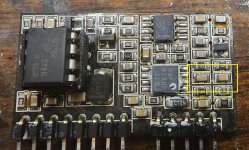My friends, this is a post full of satisfaction.
The amp works!!!! 😎
For six months I simply ignored the most trivial thing .... I just had to increase the operating current: MORE AMPS it wonted only MORE AMPS.
I always thought limiting the current would limit further damage, But I was wrong.
Now I finish the assembly and put it under test.
Thank you all for your valuable advice and your patience. I will keep you updated on developments.
The amp works!!!! 😎
For six months I simply ignored the most trivial thing .... I just had to increase the operating current: MORE AMPS it wonted only MORE AMPS.
I always thought limiting the current would limit further damage, But I was wrong.
Now I finish the assembly and put it under test.
Thank you all for your valuable advice and your patience. I will keep you updated on developments.
no, I didn't. About 15 Amps on startDid you use a current limiter on the power supply? At what amperage did it start?
Hi Dan, yes I had seen but I didn't realize that all those Amps were only needed for the start.... I imagined that 20 Amps were needed for operation after the start..... in life you never stop learning. Thanks again for everything
🙂
🙂
hi all guys, taken by the enthusiasm of the green led on, I ignored an anomalous behavior of my VFL. Without an input signal it oscillates at 13.982KHz and logically this translates into an annoying "whistling" which is also heard on the loudspeaker. Do you have any idea about it? which IC generates the PWM signal?
Does it sound like this?
https://www.bcae1.com/temp/cooleditmixedoscillator01.wav
Does it oscillate at a higher frequency (what frequency) when you drive a signal into it?
https://www.bcae1.com/temp/cooleditmixedoscillator01.wav
Does it oscillate at a higher frequency (what frequency) when you drive a signal into it?
no, Perry. What comes out of my amp is a fixed frequency at around 14KHz. The output inductors resonate and also get hotter.Does it sound like this?
when a signal is sent to it, it is modulated along with this 14KHz frequency.
what should be the correct oscillation frequency for this amp?
no, it's not coming from the preamp circuit, but I can check better tomorrow.
All the mosfets are detached from the chassis and tend to heat up a bit... I'm afraid to keep it on for a long time.
All the mosfets are detached from the chassis and tend to heat up a bit... I'm afraid to keep it on for a long time.
You can make temporary heatsinks With some aluminum stock (properly insulated from the FETs) and office supply binder clips.
Hi friends, sorry but my notifications were blocked and I didn't see your kind replies.
In fact, the oscillation frequency turns out to be too low. I would like to understand which chip is responsible for generating the PWM signal.
At start up, with the capacitors flat, the amp doesn't oscillate, but if I inject an input signal it starts oscillating at 14kHz. If I turn off the amp, remove the input signal and turn the amp back on, it resumes oscillating at 14khz. To stop the self-oscillation I have to turn everything off and discharge the capacitors.
In fact, the oscillation frequency turns out to be too low. I would like to understand which chip is responsible for generating the PWM signal.
At start up, with the capacitors flat, the amp doesn't oscillate, but if I inject an input signal it starts oscillating at 14kHz. If I turn off the amp, remove the input signal and turn the amp back on, it resumes oscillating at 14khz. To stop the self-oscillation I have to turn everything off and discharge the capacitors.
Last edited:
This is a self-oscillating amp, not a clocked amp that would have a dedicated triangle wave generator. Feel free to correct me if this is a clocked amp (would make troubleshooting easier).
The oscillation frequency is sometimes determined by the small capacitors at the input to the class D driver. The ones highlighted in the diagram may be those caps.
Is your 2184 driver in a socket?
The oscillation frequency is sometimes determined by the small capacitors at the input to the class D driver. The ones highlighted in the diagram may be those caps.
Is your 2184 driver in a socket?
Attachments
- Home
- General Interest
- Car Audio
- AmericanBass VFL competition 20k in protect mode
